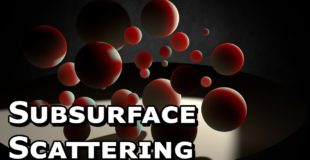https://i.ytimg.com/vi/48Ag0zLL9zA/hqdefault.jpg
+ Light penetrates the surface of an object
+ Scattered in the material
+ Some light leaves the surface at a different point.
+ The more distance the light travels before exiting, the more it will be absorbed
+ Thicker areas will absorb more than thinner ones.
+ Most shaders we have used so far are direct surface scattering
Resource LINKS…
+ Lecture DISCUSSIONS Forum: https://community.gamedev.tv/tags/c/blender/s08-the-human-head/cbc_s08_subsurface_scattering
+ Lecture Project Changes: https://github.com/CompleteBlenderCreator/08.Human.Bust/commit/2405e14e2076baced6bb1c4d42dbffb1aa692a02
source

9 responses to “Subsurface Scattering In Blender”
This is easily the best sub surface scattering tutorial I've seen, not necessarily because it was great (although it was marvelous and explained things well) but because the others are not that great.
Thanks for taking the time to explain the basics.
Michael Bridges? Any relation to Sam Bridges?? :0 (Death Stranding reference)
very clear and to the point. thank you
it is better with principled shader
Are you CPU rendering? If not, you should up the size of your tiles.
8:57 LoL.
you're using using multiple subsurface scattering nodes but they overlap each other, right? it's not like the 'deep' layer is confined to the deep parts of the image, it's also present in the top layer.
Very helpful, and most importantly, straight to the point. Thank you!
Just curious though, why keep the roughness on the Diffuse low? Doesn't that basically negate it?
How would this work with the new principled shader? Would we just replace the sss nodes with principled shaders?